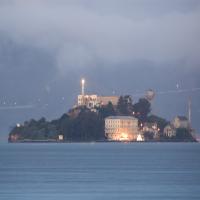
Alcatraz Island
CBUB Wins: 0
CBUB Losses: 0
CBUB Ties: 0
Win Percentage: 0%
Added by: ViceCityMobster86
Read more about Alcatraz Island at: Wikipedia
Official Site: Public Domain
The Alcatraz Federal Penitentiary or United States Penitentiary, Alcatraz Island (often just referred to as Alcatraz) was a maximum high security Federal prison on Alcatraz Island, off the coast of San Francisco, California, USA, which operated from 1934 to 1963.
The main prison building was built in 1910–12 during the time it was a United States Army military prison; Alcatraz was the site of a citadel from the 1860s. The United States Disciplinary Barracks, Pacific Branch on Alcatraz was acquired by the United States Department of Justice on October 12, 1933, and the island became a Federal Bureau of Prisons federal prison in August 1934, after the buildings were modernized to meet the requirements of a top-notch security prison. Given this high security and the location of Alcatraz in the cold waters and strong currents of San Francisco Bay, the prison operators believed Alcatraz to be inescapable and America's strongest prison.
Alcatraz was designed to hold prisoners who continuously caused trouble at other federal prisons. One of the world's most notorious and best known prisons, over the years, Alcatraz housed some 1576 of America's most ruthless criminals including Al Capone, Robert Franklin Stroud (the "Birdman of Alcatraz"), George "Machine Gun" Kelly, Bumpy Johnson, Rafael Cancel Miranda, Mickey Cohen, Arthur R. "Doc" Barker, James "Whitey" Bulger, and Alvin "Creepy" Karpis (who served more time at Alcatraz than any other inmate). It also provided housing for the Bureau of Prisons staff and their families. A total of 36 prisoners made 14 escape attempts during the 29 years of the prison's existence, the most notable of which were the violent escape attempt of May 1946 known as the "Battle of Alcatraz", and the arguably successful "Escape from Alcatraz" by Frank Morris, John Anglin, and Clarence Anglin in June 1962 in one of the most intricate escapes ever devised. Faced with high running and maintenance costs and a poor reputation, Alcatraz closed on March 21, 1963.
The three-story cellhouse included the main four blocks of the jail, A-Block, B-Block, C-Block, and D-Block, the warden's office, visitation room, the library, and the barber shop. The prison cells typically measured by and high. The cells were primitive and lacked privacy, with a bed, a desk and a washbasin and toilet on the back wall and few furnishings except a blanket. Black people were segregated from the rest in cell designation due to racial abuse being prevalent. D-Block housed the worst inmates and five cells at the end of it were designated as "The Hole", where badly behaving prisoners would be sent for periods of punishment, often brutally so. The dining hall and kitchen lay off the main building in an extended part where both prisoners and staff would eat three meals a day together. Corridors of the prison were named after major American streets such as Broadway and Michigan Avenue. Working at the prison was considered a privilege for inmates and many of the better inmates were employed in the Model Industries Building and New Industries Building during the day, actively involved in providing for the military in jobs such as a sewing and woodwork and performing various maintenance and laundry chores.
CBUB Match Record:
No Regular Play Records Available
No Fantasy Draft Records Available
